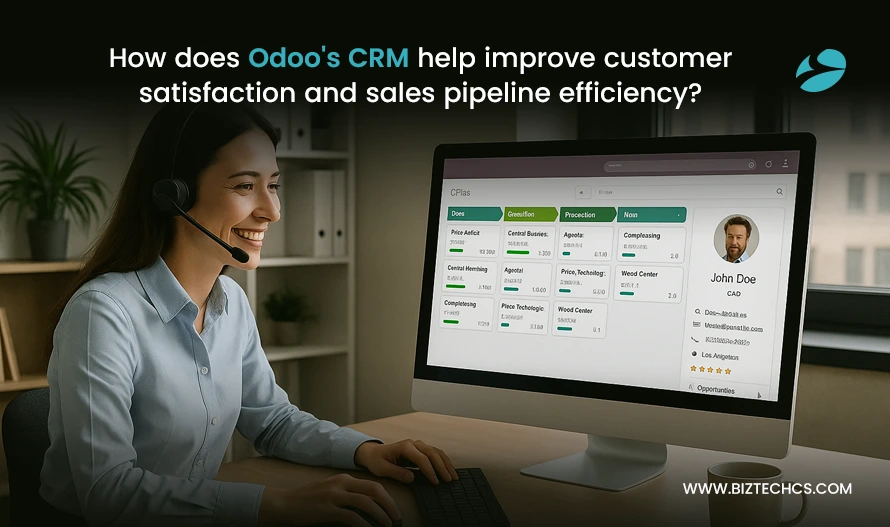How does Odoo's CRM help improve customer satisfaction and sales pipeline efficiency?
01 Aug, 2025
5 min read
01 Aug, 2025
5 min read
Table of Content

Let’s start with something you’ve probably experienced—but would rather not repeat.
It’s 3 AM. Your phone lights up. It’s the operations team. There’s a stock issue, and they can’t trace it. Your warehouse manager is juggling half-updated Excel sheets, handwritten delivery notes, and urgent WhatsApp messages from different branches. Nothing adds up. Everyone’s scrambling. And you already know this is going to spiral by morning.
Now, picture this scenario—because it happens more often than you think.
You’re running a company like Gulf Industrial Supplies in Dubai. A well-established player in the market. You’ve scaled from a small family operation to a team of over 200 employees. Your footprint spans major infrastructure projects across Abu Dhabi, Riyadh, and beyond.
But while your business has grown, your systems haven’t kept up.
Each branch continues to manage operations using its own spreadsheets. Procurement is buried in long email threads. Inventory updates are inconsistent and often require manual intervention. Real-time visibility across warehouses, currencies, and VAT jurisdictions? Nearly impossible.
Then comes the wake-up call.
During a routine audit, you discover a discrepancy of AED 2.3 million between your physical stock and your financial records. In the UAE, where VAT compliance demands full traceability, and in Saudi Arabia, where e-invoicing regulations are tightening rapidly, this isn’t just inefficient—it’s a serious legal risk.
And that leads to a much bigger question:
How do you prevent your business from becoming one of the horror stories?
Here’s what the data shows: 50–75% of ERP implementations fail to meet their objectives, and cost overruns average 189% (source).
The problem isn’t just picking the wrong ERP. The real issue is implementation—when businesses try to “plug in” a system without aligning it with their actual workflows, compliance obligations, and regional complexities.
This is where your approach needs to be different.
Before you even think about software, your first step should be to map out your cross-border transactions and compliance obligations. In the GCC, VAT treatment isn’t one-size-fits-all—UAE applies a 5% rate, Saudi Arabia applies a 15% rate (source), and export destinations each bring their own regulations.
The good news? Platforms like Odoo are built to manage these complexities.
With proper configuration, Odoo effectively handles multi-jurisdictional tax rules by utilizing built-in fiscal positions, automated mappings, and rule-based tax logic. But none of that matters if the system is set up reactively—after your audit flags the gaps. Compliance isn’t something you fix later. It has to be designed into your operations from day one.
If you’ve been struggling with VAT mismatches, manual processes, or visibility gaps across your supply chain, this is the opportunity to address them before they become a crisis.
With the right strategy, Odoo isn’t just an ERP. It becomes the backbone of compliant, scalable, and fully integrated operations, built for growth across borders.
When you walk into a client’s headquarters, the first thing you often encounter is skepticism, especially from the CFO, who might ask:
“We’ve looked at several ERP vendors, and they all promise the same thing. What makes your approach different?”
Here’s what you’d explain:
Successful ERP implementation isn’t about the software—it’s about understanding where out-of-the-box modules truly excel, and where strategic customization creates real competitive advantage.
You would typically start with Odoo’s Inventory Management and Accounting modules because these are areas where Odoo performs exceptionally well right out of the box. But why begin with these modules? Because Odoo’s inventory engine handles multi-location, multi-currency, and multi-company scenarios reliably, without needing customization.
It just works. Barcode integration, automated reorder rules, and real-time stock valuation are already built in and operate seamlessly, even in complex warehouse networks.
Now, here’s where a bit of strategic customization really shines.
Imagine having real-time visibility across warehouses in Dubai, Abu Dhabi, and Jeddah—and achieving that within just two weeks. Say a project manager in Riyadh requests 500 steel beams.
With this setup, the system would instantly show available stock across all locations, pending purchase orders, and expected delivery dates, while correctly calculating VAT implications for cross-border transfers.
However, this is where the implementation strategy truly shines.
During the first month, procurement heads often raise a common concern:
“What about our existing supplier relationships and pricing agreements? We can’t just disrupt twenty years of carefully built partnerships.”
That’s when the approach shifts. Instead of forcing immediate change, you’d configure Odoo’s vendor management to mirror current supplier hierarchies and pricing structures. Then, gradual process improvements can be introduced as internal confidence builds. The system adapts to the business reality, not the other way around.
This strategy also involves setting up separate fiscal positions for each jurisdiction and utilizing Odoo’s automated tax calculation engine to ensure VAT is calculated based on the partner’s location and registration status. This eliminates the manual VAT errors that often derail GCC implementations, making cross-border transactions seamless.
In short, it’s never just about the software. It’s about tailoring the implementation to align with your current operations, while leaving room for long-term improvement and reducing risk at every step.
In the construction supply business, where vendor relationships are crucial, managing hundreds of suppliers across multiple countries can easily lead to procurement chaos. Add the complexity of ensuring compliance with each jurisdiction’s regulations, and you’ve got a full-time headache on your hands.
Here’s a question for procurement leaders: What do you do when a supplier in Saudi Arabia isn’t VAT-registered, but your purchases exceed the mandatory VAT registration threshold? This is a real-life scenario that often goes unnoticed—and it’s one of the reasons why generic ERP solutions fail to meet the needs of businesses in the GCC market.
The key here is understanding that Odoo’s Purchase Module isn’t just about tracking purchase orders. It’s about making procurement smarter, more streamlined, and fully compliant with regional requirements.
Odoo Purchase Module – Native Capabilities:
But here’s where it gets interesting. The off-the-shelf Odoo Purchase Module can cover a lot, but when it comes to GCC business realities, there’s a need for strategic customizations that address local challenges head-on.
Our Strategic Customizations:
Imagine this: you’re processing purchase orders from multiple suppliers across the region, and the system is automatically flagging potential compliance risks before they escalate. Think of it like having a radar that detects regulatory issues long before they land on your desk. The system can even handle complex VAT treatments, depending on the supplier’s location and VAT registration status.
A solid example of this is how we use Odoo’s purchase workflows, adding a layer of custom logic for supplier master data that includes VAT registration details and compliance certificates. The system utilizes custom procurement logic to ensure that every purchase order is compliant with the supplier’s jurisdiction and VAT registration thresholds. By building this validation directly into the workflows, we help businesses avoid last-minute surprises and maintain a smooth, compliant process.
We typically see significant improvements by month six, including:
However, perhaps the most significant change is in how procurement teams can shift their focus from firefighting administrative tasks to nurturing strategic relationships with suppliers. The system handles the compliance complexities, allowing your team to focus on what truly matters.
By tailoring Odoo’s workflows to meet the unique needs of the GCC market, we enable businesses to be more proactive, efficient, and ultimately, more profitable. So, if you’re in procurement and facing the challenges of multi-country, multi-regulation supply chains, this approach is a game changer.
Nine months into transformation, companies typically achieve operational excellence internally. But operational efficiency is just table stakes. The real competitive advantage lies in leveraging that operational foundation to enhance the customer experience and accelerate revenue growth.
Over more than fifteen years of Odoo implementations, one thing consistently stands out:
It’s not the operational wins that set leaders apart—it’s how they turn those wins into growth.
This is where we’d introduce Odoo’s CRM and Sales modules—areas where Odoo shines without heavy customization. The transformation becomes immediately visible to customers.
Project managers could log into a customer portal to check real-time order status, view detailed delivery schedules, and access digital copies of compliance certificates. But here’s where our understanding of B2B construction dynamics would make the difference.
Sales directors often ask us: “What about our complex project-based pricing and long-term contracts? We have tiered pricing based on annual volume commitments, project-specific discounts, and multi-currency contract terms.”
This complexity is exactly why we build such solid operational foundations first. The system would manage all of these pricing variations while maintaining accurate margin visibility for management. But more importantly, the CRM integration reveals previously invisible insights.
We typically see these customer satisfaction improvements:
Here’s something interesting we often uncover: Integrated systems reveal payment pattern insights that enable proactive cash flow management and informed credit decisions. Have you ever wondered why some customers consistently pay late while others pay early? The data tells the story, but you need integrated systems to see it.
Odoo’s customer portal framework is exceptionally flexible out of the box. We configure it to display compliance documentation alongside order history and create custom document templates for VAT certificates. Using Odoo’s automated workflow engine to deliver e-invoicing documents seamlessly, the portal becomes a competitive differentiator when properly configured.
Twelve months into digital transformation, companies face the true test of any GCC ERP implementation: financial reporting and regulatory compliance. Saudi Arabia became the first GCC country to increase its standard VAT rate to 15% in 2020, creating complex multi-jurisdictional compliance scenarios that most ERP systems weren’t designed to handle.
This is where our technical architecture decisions made months earlier prove their value. We design Phase 4 to address sophisticated financial reporting requirements that emerging businesses face as they scale across the region.
When CFOs ask us, “What happens when Saudi e-invoicing mandates go into full effect for our B2B transactions?” We can demonstrate how we’d configure Odoo to generate ZATCA-compliant invoice formats and maintain the detailed audit trails that Saudi authorities require.
This is a forward-thinking ERP implementation. We don’t just solve today’s problems—we build architecture that accommodates tomorrow’s regulatory changes.
We typically deliver this financial transformation value:
But the strategic breakthrough comes with management reporting. For the first time, leadership would have real-time visibility into profitability by customer, project, product category, and geography.
Odoo’s accounting engine handles multi-company scenarios brilliantly, but GCC compliance requires strategic configuration. We set up separate journal sequences for each VAT jurisdiction while maintaining a consolidated chart of accounts for group reporting. We build automated inter-company elimination rules and currency conversion workflows. The key is treating compliance as system architecture, not bolt-on functionality.
According to Panorama Consulting Solutions’ research, successful ERP implementations increasingly focus on business process optimization rather than just technology deployment. Companies typically achieve measurable ROI within eight months, primarily through eliminating manual processes and improved decision-making based on real-time data.
Let me share what the final outcome could look like, as it illustrates a crucial aspect of our approach to ERP implementation. Eighteen months after starting an ERP journey, companies evolve from operationally focused distributors into strategically managed growth companies. The transformation isn’t just about software—it’s about building business capabilities that enable intelligent decision-making and sustainable scaling.
Data flowing through integrated Odoo systems powers strategic decisions that would be impossible before. When major infrastructure projects open opportunities in Qatar, management could instantly model the financial impact: required inventory investment, supplier relationship requirements, regulatory compliance costs, and expected profitability timelines.
Should you establish a Qatar operation or serve that market from your UAE base? This strategic question could be answered with data rather than intuition.
We typically see this measurable business impact after 18 months:
But here’s what I want you to remember: industry studies show that failed ERP implementations often result from poor planning rather than software limitations. Our methodology demonstrates that success comes from treating ERP as a business capability project rather than a technology installation.
Before we wrap up, let me address the questions I know you’re thinking about. What questions should you be asking potential ERP partners to avoid becoming another failure statistic?
How would you leverage Odoo’s native capabilities while implementing strategic customizations where they are needed? What specific experience do you have with GCC compliance requirements? How would you transfer knowledge to our team for long-term independence? What measurable business outcomes could we achieve within six months?
These aren’t vendor qualification questions—they’re strategic implementation questions. The difference matters.
Our approach proves that understanding which Odoo modules work brilliantly out-of-the-box—and where targeted customization creates competitive advantage—makes the difference between implementation success and expensive failure.
All product and company names are trademarks™, registered® or copyright© trademarks of their respective holders. Use of them does not imply any affiliation with or endorsement by them.

68
By Biztech
09 Oct, 2025

74
By Biztech
09 Oct, 2025

91
By Biztech
06 Oct, 2025